Let’s meet a mimic octopus today – a master of disguise. In its natural state, the mimic octopus is light pale and like most octopuses, it changes its skin color to blend in with the surroundings. Many octopuses do this, but the mimic octopus takes things to another level altogether.
The mimic octopus can be found in Indonesia and the Great Barrier Reef. It was discovered relatively recently, in 1998. Possibly because, up until then, it had done such a good job of disguising itself. The mimic octopus is very intelligent and an expert at deception.
Do you want to know about this beautiful and unusual sea creature and how it mimics the colors and patterns of prey species? This article tells you a little bit more about the mimic octopus. The mimicking skill of the mimic octopus shows how similar they are to birds and even mammals and is very interesting and well worth a read.
About Mimic Octopus – A Quick Biology
Let’s have a glance at this fascinating species and find out a little more about this unusual creature:
| Parameters | Details |
| Scientific name | Thaumoctopus mimicus |
| Kingdom | Animalia |
| Family | Octopodidae |
| Genus | Thaumoctopus, Norman & Hochberg, 2005 |
| Phylum | Mollusca |
| Class | Cephalopoda |
| Order | Octopoda |
| Species | T. mimicus |
| Habitat | Shallow waters with sandy or silty bottoms |
| Life Span | 1-2 years |
| Diet | Carnivores |
| Geography | Indo-Pacific; Northeast Australia, New Caledonia, Papua New Guinea, Indonesia, Philippines, and the Red Sea |
Mimic Octopus Encyclopedia: Top 10 Facts
Let’s discuss the mimic octopus in detail. We are going to discuss the top 10 facts in the section below:
1. Description and distribution
Research given at Mapress about Thaumoctopus mimicus (mimic octopus) states the following locations where it is distributed:
“Mimic octopuses are found in the tropical waters of the southwestern Pacific Ocean. They reside close to Lizard Island in northeastern Australia. From there, they can be found all over Papua New Guinea and New Caledonia. Through Indonesia, their range is further expanded. the Philippines in the north, and the Red Sea in the west.” (Source)
According to the article given by Octopus Worlds:
“You will see Thaumoctopus mimicus in Southeast Asia along the coast of Sulawesi. You will have the best chances to find them in Alor, Bali Ambon, Lembeh – Indonesia, Anilao, Dumaguete – Philippines) and Mabul Malaysia in shallow areas. They may have different habitats that have just not been discovered yet. They appear to like muddy terrain and warmer water there.” (Source)
The following areas are UWPG’s top picks for Mimics, where you can discover them alongside a variety of other creatures: (Source)
- Anilao, Philippines
- Lembeh Strait, Indonesia
- Ambon, Indonesia
- Dumaguete, Philippines
- Tulamben, Bali (Indonesia)
- Puerto Galera, Philippines
They love open sand or silt bottom in somewhat shallow water and are naturally brown. At the beginning of a dive or the surface interval at the end of a dive, dive guides frequently search for mimic octopuses.
2. Appearance
The mimic octopus is a smaller species of octopus, reaching a total length of around 60 cm (2 ft or 0.6 m) when its arms are extended and with arms that are roughly the diameter of a pencil at their widest point. The mantle is only 2 inches long. Therefore, the arms may be 7 to 10 times as long as their mantle. Each eye has a little horn sticking out of it. Their skin is smooth and they have a “U-shaped” dorsal mantle.
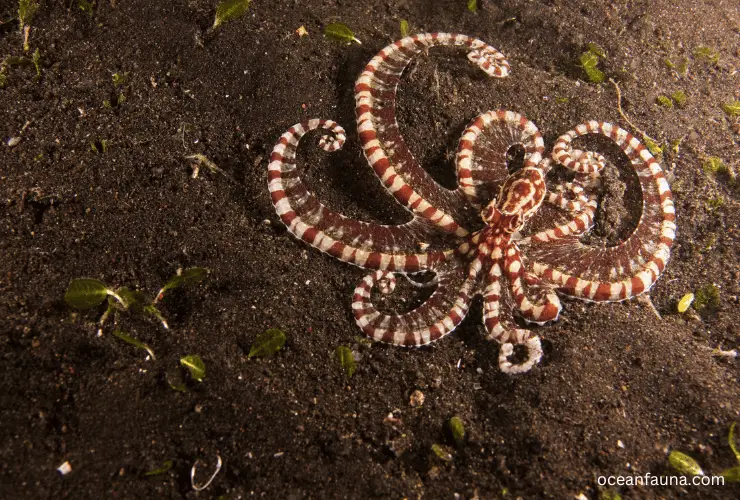
They do feature tiny protrusions around the mantle’s edge known as “papillae.” Additionally, each eye has long, pointed papillae covering it for defense. Along the length of their arms, they have 283 suckers. Although the octopus’s normal color is light brown or beige, it frequently adopts a more conspicuous pattern of white and brown stripes to frighten away predators. (Source)
It does this by mimicking toxic species and aggressive, territorial marine critters. These cephalopods have their eight arms outstretched and they walk on these arms. It’s almost like a walking Chewbacca, but without black fur. But we should not be too quick to dismiss the octopus for any appearance that has no apparent function. The mimic octopus in its second form may not be as cute, but it has a strange talent.
3. Behavior
The mimic octopus searches for prey, usually small fish, crabs, and worms, by shooting a jet of water from its funnel and gliding over the sand. It favors river mouths and estuaries over reefs, which are typically favored by other types of octopus as shelter. This is because it can pass for poisonous creatures, which puts it at a lower risk of being eaten than other animals out in the open.
It is said that appearances are often deceptive; this idiom perfectly fits the mimic octopus. Numerous different species of animals, some of which are copied by mimic octopuses more frequently than others, have been seen. Among the animals that have imitated or mimicked humans are:
- Lionfish (in which the octopus extends its arms in a manner that resembles the fish’s spines);
- Sea serpent / Sea snake (hiding 6 of its arms, it holds the remaining 2 parallel to each other),
- Jellyfish (by spreading its arms behind it and inflating its mantle), and
- Zebra sole (holding all 8 arms behind it as it uses its siphon to swim)
Nearly 500 instances of the octopus imitating flatfish were seen over 5 days, suggesting that this is its favored disguise. (Source) The mimic octopus not only uses its ability to ward off predators but also employs aggressive mimicry to approach wary prey. For instance, it may imitate a crab as an apparent mate before consuming the duped suitor.
Even so, the mimic octopus can blend in with its sandy surroundings. Additionally, it was noted to imitate sessile creatures like tiny sponges, tube-worm tubes, or colony tunicates. Depending on the circumstances, the octopus may be able to use imitation intelligently. It chooses the right mimicking behavior and carries it out.
4. Habitat and range
Recall how the sea snake-impersonating mimic octopus may conceal itself inside a burrow. That’s understandable, given that they are skilled burrowers and diggers. They are even capable of excavating their own burrows and moving via tunnels beneath the ground.
Even sticking their arms inside holes at random to hunt for food doesn’t frighten them. Most octopuses only emerge at night (they are nocturnal). They can better conceal themselves from predators throughout the night. However, the mimic octopus can be active all day since it is a master of disguise.
But when they need to relax, how can they remain secure? Easy! They benefit from the sand-based substrate. When they need to snooze at night, they’ll only retreat into their burrows. They’ll bury their entire body under the sand during the day, leaving only their eyes protruding. This enables them to monitor what is happening while they relax.
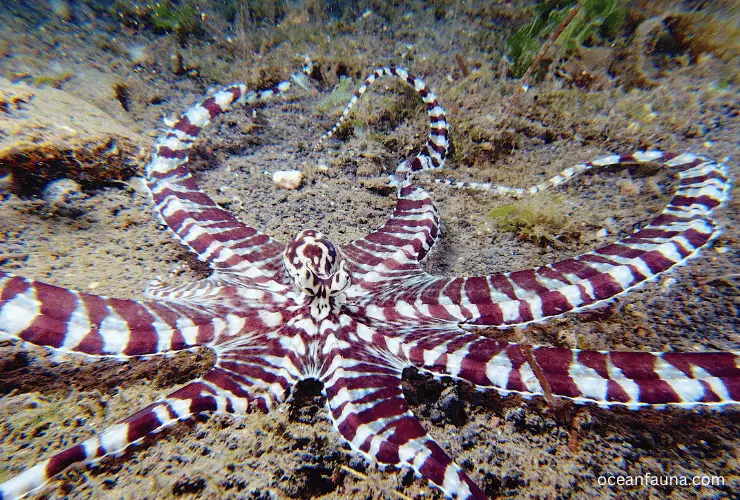
WikipediaThe Wikipedia organization has described its habitat and range in the following words:
“The mimic octopus was initially found in 1998 on the bottom of a murky river mouth off the coast of Sulawesi, Indonesia. Since then, researchers have discovered that it lives throughout the Indo-Pacific, from the Red Sea and Gulf of Oman in the west to New Caledonia in the east, and from the Gulf of Thailand and the Philippines in the north to the Great Barrier Reef in the south.
Indonesian records are the most widely available. It is mainly located at depths of less than 15 meters in sand or silty environments (49 ft). To blend in with the murky, muddy sea floors around it, it prefers to do so.
It’s possible that in the event of a perceived threat, such as a boat with divers in it, the octopus may lift off the seafloor with the tendrils at the tips of its tentacles, shake itself dry with water vapors on the surface of the water, and float back to the surface.” (Source)
5. Feeding/Diet
The mimic octopus falls into one of two categories: a hunter or a forager. Scientists have seen and documented the octopus’s capacity to pursue prey, hunt down small fish, and catch them, leading them to assume that it is a hunter. But the mimic octopus is more frequently observed looking for food.
It accomplishes this by gliding over the sand while hunting for prey using a jet of water from its siphon. It then reaches into cracks in coral and holes in the sand with its delicate tentacles and utilizes its suction cups to grasp small crustaceans to consume them.
The mimic octopus is thought to eat virtually solely tiny fish and crustaceans because it loves to reside in shallow, muddy environments. That’s because a mimic octopus can only subsist on those two creatures, which is typical of those circumstances. They are thought to be carnivores and are not known to consume any kind of vegetation or plants.
Octopus Worlds’ authors have described their food habits in the following words:
“They are renowned for engaging in cannibalism as well. The intriguing thing about that, though, is that when alternative food sources are there, they will eat each other. According to experts, cannibalism has nothing to do with surviving. Instead, they focus on preserving dominance over a certain region of land.” (Source)
6. Reproduction system
The male mimic octopus uses a “hectocotylus,” like all male octopuses, to mate. A specialized arm is a hectocotylus. They use it to transmit a tiny sperm package known as a “spermatophore.” The sperm will be transferred right away. Sometimes the male may merely give the female his spermatophore. Until she is ready to utilize it, she will keep it secure.
The male of this octopus inserts a sack of sperm within the female’s mantle during the reproduction process. Within a few months of this happening, the man will pass away. Up until the time that her eggs are ready to be laid, the female will carry the sperm sac for several months.
She will utilize the sperm to fertilize them as she lays strings of them. She will continue to keep the egg strings tucked safely under one of her arms. As she moves, her suckers will keep them from falling into the water.
She will also pass away when the eggs are ready to hatch. From the moment they hatch, the young Mimic Octopus must survive on their own. To locate enough food, they will strive to survive at the surface of the water. Only 1-2% of octopuses survive to adulthood.
197 eggs were counted in one still image where the egg mass was partially visible. There may have been more than 300 eggs total in the entire brood. Instead of being laid in a nest like many other octopus species, these eggs were carried by the female in strings of three or four. (Source)
7. Cardiovascular and nervous system
Mimic octopuses have elaborate cardiovascular and nervous systems. The cardiovascular system includes three hearts (two pump blood to the gills so that it can get oxygen, and the third spreads blood to the rest of the body). Unlike human blood, mimic octopus blood is copper-based which makes it appear blue.
The octopus nervous system includes its brain, but ⅔ of the neurons are found throughout its body, especially in its arms. Researchers refer to each of an octopus’s eight arms as a “mini-brain.” This means the arms have a significant level of control and sensory capabilities. They may even still reach or grasp after they are severed. And their suckers can sense chemicals, in other words, smell or taste. (Source)
8. Anatomy of the mimic octopus
The brown and white stripes on the mimic octopus, as well as its 60-cm size, are distinguishing features. It is a soft-bodied mollusk with a narrow waist and eight long arms covered in two rows of suckers.
All of the internal organs are housed in the mantle, often known as the head. The octopus is propelled through the water via a siphon that may be located on the mantle (jet propulsion).
9. Ecology
As a predator, the mimic octopus has a significant ecological function. They are experts at disguising themselves, which keeps them from becoming victims. However, they feed on smaller species of animals that provide population management.
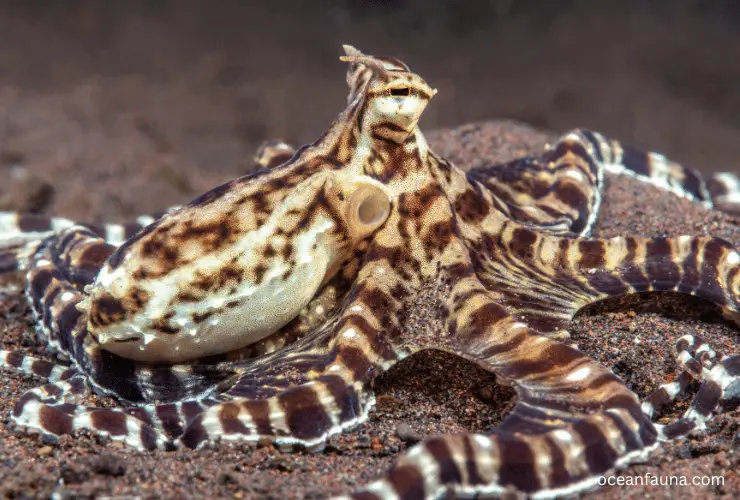
In 1998, the mimic octopus was first spotted off the Indonesian island of Sulawesi. Since then, it has been discovered in New Caledonia, Indonesia, Malaysia, the Indo-Malayan Archipelago, and the Philippines. It prefers to reside in the muddy bottoms of tropical, shallow estuaries. It is frequently seen leaving and entering sand-filled tunnels, as well as sitting next to burrows or sand mounds.
During the day, the mimic emerges to graze on sand soils. Fish and tiny crustaceans make up its diet. Even though they are a relatively new kind of animal, there is increasing demand for diving for them and selling them alive in captivity. But the octopus doesn’t use its mimicry skills when it’s in captivity. (Source)
10. Deadly Octopus Ink
National Geographic organization has talked about the deadly ink of a mimic octopus. According to their article, octopus ink is deadly even for the octopus itself.But the question has arrived here: what is deadly octopus ink? Let’s answer what National Geographic says about it:
“The ink is a seemingly innocent mixture of mucus and melanin. Melanin, the same dark pigment found in skin, hair, and eyes, also has a chemical compound named Tyrosinase which can impair sight, taste, and smell. Mimic octopuses, on the other hand, may use their ink to distract, confuse, and paralyze their predators.
This mucus mixture may even block a fish’s gills, causing the fish to suffocate. “If an octopus cannot escape its own ink, its respiratory system can be compromised, causing the octopus to suffocate and then die due to the deadly ink.” (Source)
Why Is It Called the Mimic Octopus?
The only member of its genus is the mimic octopus, Thaumoctopus mimicus. Despite being identified in 1998, the species wasn’t given a name until 2005. Naturally, their moniker/name derives from their propensity for animal impersonation and mimicry skills.
Its name depicts its habits and lifestyle. Its capacity to alter its shape, which serves as its primary defense in addition to camouflage, is the reason it was given the nickname “mimic” octopus. Its mimicry skills seem quite cute and adorable!
Most Interesting Facts About Mimic Octopus: Special Characteristics
Let’s discover some of the most interesting facts about mimic octopuses:
● They can do mimicry
There are many interesting facts associated with the mimic octopus, but mimicking is one of the first and foremost fascinating facts that needs to be mentioned here. Let’s discuss it in detail below.
Most mimicking creatures can only mimic one other species. According to research, the mimic octopus can convincingly mimic three other species. Still, divers claim to have observed mimic octopuses impersonating a variety of different species.
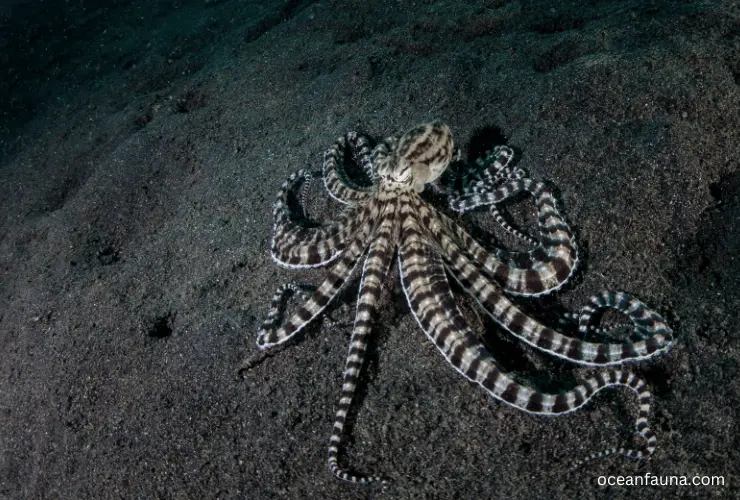
We have described before in the above section that it has been known to mimic animals like lionfish, sea snakes, jellyfish, and zebra soles. The majority of researchers think they can mimic at least 15 different species.
CreationWiki organizations’ authors have described that divers claim they have observed them mimicking many species, including (Source)
- Anemones
- Stingrays
- Crocodile snake eels
- Nudibranchs
- Sponges
- Tube worms
- Colonial tunicates
- Feather stars
- Giant crabs
- Mantis shrimp
- Seahorses
- Sole (flatfish)
Depending on the type of predator present, mimic octopi can decide which predator to imitate. For instance, it will frequently “morph” into a sea snake if it detects a damselfish. Since sea snakes are one of the main predators of damselfish, this tactic is very successful.
Below are three of their well-documented mimics:
- Sole Fish – Flat and somewhat swift, sole fish can be seen swimming across the ocean’s bottom. The Mimic Octopus will arrange all of its long arms behind its body and use jet propulsion to mimic the movements of this poisonous fish. They mimic a stingray by performing the same motion while dragging one arm behind them.
- Lionfish – A fish with brown and white stripes and 18 venomous spines on its body is called a lionfish. The Mimic Octopus spreads out its arms to resemble the long spines of the lionfish while matching their color. When a fish sees this, it will hesitate before biting since it doesn’t want to deal with the discomfort of being stabbed in the mouth while trying to feed.
- Sea Snakes – The Mimic Octopus sticks two of its arms out in opposite directions to resemble the banded sea snake while tucking itself into the sand or a hole. It mimics the sea snake’s undulating movements while displaying black and white bands similar to those of the sea snake.
You cannot deny that it is great, can you?
● They are intelligent sea creatures
The second amazing fact about this marine creature is: mimic octopuses are intelligent. Yeah, some scientists believe octopus intellect can be found in their ability to use tools and exhibit foresight.
They do this to retain complex memories which helps them navigate mazes and solve puzzles, and to use visual cues, which helps them differentiate between human individuals. These octopuses have also been shown to play, an activity considered a sign of intelligence.
● These species only live between one and two years
Much of the short lifespan has to do with the mimic octopus reproduction process. When these octopuses mate, males will be strangled even by females. Males are also smaller than females, so they become overpowered and sometimes cannibalized once the sexual need is complete.
While females survive the remaining process, they die after laying their eggs. Female octopuses got their eggs prepared after 8 weeks. During that time, the female body self-destructs her cellular suicide until she dies.
● How Many Bones Do They Have?
This octopus species will put the suppleness of any yogi to shame because it lacks a stiff skeleton. The only hard portion of an octopus’s body is its beak; hence there are countless possible body configurations. This is an interesting fact!
What Adaptations Do the Mimic Octopus Have?
This master of disguise has many adaptations, but the physical and structural adaptations are worth mentioning here. The mimic octopus, like many other cephalopods, has chromatophores, or color-changing cells, covering its skin.
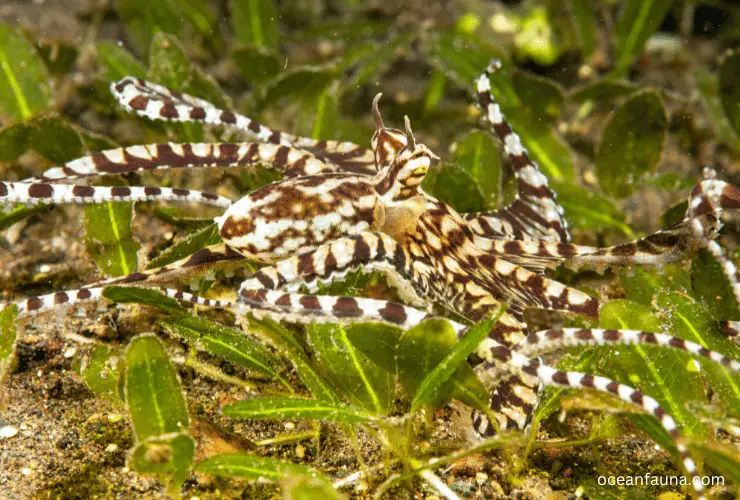
Rapidly expanding or contracting the cells enables the animal to change color and finally fit in with its surroundings. The mimic octopus, however, intensifies the trick. The animal will alter how its arms move in addition to just changing its color and texture to mimic a range of other marine species.
Thaumoctopus mimicus can gracefully extend all eight of its legs backward to mimic the shape, motion, and speed of a flounder. It can even flatten its head and place its eyes prominently like flatfishes. It can undulate across the ocean floor. It can mimic lionfish or dangerous sea snakes.
Mimic Octopus Predators: A Detailed Discussion
Let’s discuss what are the biggest enemies of mimic octopuses and how they protect themselves from these predators:
What animal eats mimic octopus?
The golden trevally, jellyfish, stingrays, sea snakes, lionfish, and poisonous sole fish are the primary predators of the mimic octopus. They are also in danger from other big bony fish species and sharks. Humans are also predators of the mimic octopus. The Indo-Malayan octopus species known as mimics are not usually eaten.
However, people continue to pose a threat to them. People want to keep mimic octopuses in their aquariums because they find them to be so fascinating. Few aquarists have worked with these rare species since they are expensive and sensitive.
How does the mimic octopus avoid predators?
Its mimicry skills and abilities make it a perfect marine creature. There are no species like it. The mimic octopus is an octopus that is so intelligent that when it feels threatened, it can fool possible predators into thinking that it is another, more deadly species.
It does this by changing its color, shape, and perhaps most interestingly, the way it moves and behaves. Sometimes the mimicry is ineffective in deceiving the predator. However, it might be sufficient to frighten and divert the predator long enough for the octopus to flee.
The mimic octopus has the same ability as other octopuses to expel an ink-like material (deadly octopus ink). This substance can keep predators off-balance while the octopus escapes.
Can Mimic Octopus See Color?
Mimic octopuses are colorblind. Their eyes can only see the white and black colors. However, a father-son team of researchers from the University of California, Berkeley, and Harvard University believes that their peculiarly shaped pupils may enable them to perceive color and replicate the hues of their surroundings. (Source)
How and Why Do Mimic Octopuses Change Color?
The answers to these questions are simple. Because it keeps them safe and secure from harmful creatures and predators, mimic octopuses decide to change their color in this way. They can alter their hue to fit in with their surroundings. Alternatively, they can adapt to mimic more threatening creatures.
To change color, mimic octopuses have unique cells called “chromatophores.” This is how they change their color. To better fit in, they can even alter the texture of their skin. The mimic octopus can imitate an animal’s actions by moving its arms like that animal. They can trick potential predators into believing they are not worth attacking. (Source)
The question that arises here is: what are “Chromatophores”? The authors from OutForia have described it as:
“Chromatophores, cells that contain color, are what allow mimic octopuses to alter their appearance. These cells are found in the skin’s deeper layers. The pattern of an animal’s skin is determined by its distribution across the body.”
Many species of animals possess chromatophores, which enable them to alter their color. The mimic octopus, however, appears to be far more skilled in this area. The mimic octopus may change color by constricting thanks to the chromatophores. Rapid cell contractions enable the animal to change its appearance in an instant.
How Long Do Mimic Octopuses Live in Captivity? A Case Study
The mimic octopus can live about four months in captivity. Although this may seem like a very short time, keep in mind that many of these were taken as adults who were already nearing the end of their natural lives. To further put this into perspective, in the first 30 days after importation from the Philippines and Indonesia, typical marine fish death rates in the pet trade might vary from 30 to 60%.
Many patterns and behaviors were captured and analyzed from the research given at ‘Magazine’ about the naughty Thaumoctopus mimicus. A captive animal was observed engaging in what appeared to be “playing dead” behavior. The final image reveals that the octopus was closely observing the photographer while it was acting dead. (Source)
How Many Mimic Octopuses Are There in The World?
The mimic octopus has not been assessed by the International Union for the Conservation of Nature. Its population trend is therefore uncertain. However, to evade predators, nine different mimic octopuses, including Thaumoctopus mimicus, were captured on camera throughout the course of the following two years, according to the research of the Marine Bio organization. (Source)
These beastly creatures are more and more in demand for commerce. This might put their populations in jeopardy. There may not be many of these octopuses, yet we are unsure of their population size. Even for scientific reasons, sightings are few and challenging to locate.
FAQs
Where do mimic octopuses live?
They favor sandy or silty bottoms in shallow waters. They inhabit depths from 1.5 feet (0.5 meters) and 121 feet (37m). Habitats at the river and estuarine mouths frequently fall under this category.
The majority of octopuses favor reef settings because they have lots of places to hide. The mimic octopus’s habitat leaves them exposed with few places to hide. They probably acquired their ability to mimic because of this.
Additionally, they are skilled diggers and will create their tunnels on the sand. They can take a burrow from fish, crabs, or worms if they don’t feel like making their own.
Are mimic octopuses poisonous?
Yes, mimic octopuses are poisonous just like blue-ringed octopuses. The venom in the mimic octopus’ saliva can paralyze and kill its prey.
Are mimic octopuses endangered?
There is no certain answer to this query because its population and conservation status are still unknown. No one knows whether it is endangered or stable in its population status.
Although mimic octopuses are seriously affected by habitat destruction and water pollution these are not considered endangered species of octopuses.
What can the mimic octopus turn into?
The mimic octopus can easily be into 15 other species including lionfish, jellyfish, sea snakes, shrimp, crab, and others.
Is the mimic octopus a carnivore?
Yes, the mimic octopus is a carnivore. They can eat whatever they catch. However, their favorite food includes echinoderms, crustaceans, fish, and worms.
How big can a mimic octopus get?
A mimic octopus can get as big as only 2 feet. In other words, it can get 60 cm in length including arms.
How many species of octopus are present in the world?
There are more than 300 species of octopus recognized by scientists. Oceans all across the world are home to them. They can live in either warm or cold climates and are only found in salt water. They come in a variety of sizes, from very small to rather huge. There are many misconceptions regarding these animals out there.
How big of a tank does a mimic octopus need?
A tank of 50 to 75 gallons is good enough for captivating a mimic octopus. A second large tank will also be needed for filtration purposes.
Conclusion
Mimic octopuses are cute creatures, and their behavior is captivating. Mimic octopuses, like most other octopuses, love to hide in their hiding places. They are actually quite intelligent and reading and writing facts about them are worth it. I hope you enjoyed this post on the mimic octopus as much as we did. Let us know your views by commenting down below.

1 thought on “Mimic Octopus: Habitat, Description & Fun Facts”